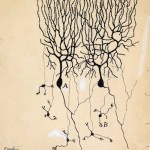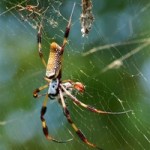
I realize this has nothing to do with energy, food or environment, but it amuses me, so a brief hiatus from relevance will be taken. As y'all know (or don't) Chanukah starts this weekend, and the household is awash in preparations, many of them involving glue sticks and song.
During the course of my life, I've had several candidates for the "Most nauseating holiday song award" - before my conversion to Judaism, I was an avid advocate of "The Little Drummer Boy" whose sicky sweet rumpapumpumming went on an awfully long time and seemed to be a favorite for covers by artists I already couldn't…
We're just about at the one year anniversary of the Northeastern power outage that had many people out this way out for a week or two last year, and what's the forecast up at our place? Snow, followed by sleet and icy rain and more ice. This seems like a recipe for trouble.
Being of a vaguely apocalyptic mindset, your blogiste is pretty good for a power outage, but it occurred to her that not everyone is probably ready. In fact, despite the fact that FEMA has *said* that in a crisis it may not be able to reach people immediately, despite the fact that an awful lot of Americans had extended…
If your loved ones are at a loss this holiday season as to what shiny objects might most set your cardiac muscle aflutter, quick! You're running out of time. But you are not alone! It's tougher to shop for science nerds than might be imagined. After all, a Sagan lover is not a Kevin J. Anderson lover is not an Arthur C. Clarke lover, and you really have to be careful even with generic gifts - you wouldn't want to send a fruit basket to a psychologist, would you?
And of course, as geeky as some of us truly are, nobody really needs a periodic table shower curtain or a cheeky mug. We like…
I was about to post the Chocolate-Banana Bread Pudding recipe that I left out of my food waste post, when I found myself worrying a little bit about whether posting recipes is appropriate for my new forum. You see, I tend to think of Scienceblogs with the first syllable pronounced just like Thomas Dolby in "She Blinded Me With Science" yelling "SCIENCE!" (which I have included a link to for no apparent reason, simply because it pleases me http://www.youtube.com/watch?v=V83JR2IoI8k.) Is this warm, fuzzy, chocolatey goodness appropriate to a hard-edged SCIENCEblog? Does PZ Myers post…
Last year I was invited to speak at a Green Energy Event in the West. Most such events make their actual money from their vendor halls, and this one had as one of its focal events the premier of the new Ford Hybrid, which was just being released. Thus, there were many Ford executives at the event. I arrived early to the drinks-and-food-for-the-speakers-and-vendors bit the night before the event formally began, since I had been told it would take longer for me to walk there than it did, and the only other person present from the event was a Ford executive. We got to talking - he was a…
Ok, those of you who know me know that I am not much of a consumer. If I can buy it used, make it myself, or make do with something I've already got, I'm pretty good. I hate the frenzy of shopping that accompanies the "Holiday" season, and I think the most awesome thing about being Jewish is that Chanukah is a minor holiday, and generally I'm sitting around with my feet up while everyone else is racing around.
I'm a big fan of homemade gifts - this year most of the grownups in my family got homemade jams and such, and a bunch of meat chickens, raised at home at my house. Now I realize…
The subject of food waste is not sexy. Anyone faced with the statistic that we waste 40% of our food in America is almost certainly appalled - for a second or two. But they also probably stop thinking about it just a tiny second later, probably after a moment of thinking "not us, though." And yet, it almost certainly is us.
A recent study is very clear about the costs of wasted food - food waste has risen by 50% in my lifetime, and the average American now wastes 1400 kilocalories a day of food. That adds up to 1/4 of all freshwater use, 300 million barrels of oil spent in agriculture (…
Dear Readers,
It is our great pleasure to bring you news of an exciting new partnership, starting today, between ScienceBlogs and National Geographic.
ScienceBlogs and National Geographic have at their cores the same ultimate mission: to cultivate widespread interest in science and the natural world. Starting today, we will work together to advance this common mission through new content, applications, and initiatives. We will bring acclaimed voices from National Geographic into our rich discussion on ScienceBlogs, and National Geographic will invite their worldwide audience to join the…
I may be a happily married woman, but I'm not immune to seduction - who is? So when a lovely woman named Erin came around offering to fulfill my wildest fantasies, I was intrigued, if a little nervous. She promised me the moon, deep stimulation, plenty of aroused excitement, the full range of delights. It was intoxicating. And so I allowed my self to be swept away by the titillation of more and bigger and deeper. She was even open (shocking!) to getting my honey involved (more on this below). And thus, I find myself here at Science Blogs, ripe and panting to begin. The lure of more…
Fluids are a constant source of inspiration for high speed photography. Water and milk are two of the common liquids around us every day, but still their complex behavior is a source of wonder. Fluid scientists are still pioneering some of the basic equations that are responsible for the complex motion of fluids. In these pictures a drop of liquid is falling into a container of liquid. The first falling drop creates a recoil splash that shoots up out of the container. Just when the recoil droplet gets to the top of its motion a second falling droplet collides. The timing often happens…
In the increasingly competitive and admissions-driven world of high school, learning doesn't always come cheap. SAT-prep programs and college admissions counselors charge a pretty penny for the advantages they (claim to) bestow upon anxious juniors and seniors, and even younger students, including those in middle school, are feeling the pressure. But what about families who can't afford exclusive prep courses?
Enter USAGraduate.com, a interactive online competition free to students in grades 6-12 that aims to engage students in science, technology, engineering and math (STEM) subjects. The…
This week, Jessica Palmer of Bioephemera posted an illuminating report on the politics that govern—and often hamper—scientific research for drug abuse treatment. In her post, Jessica points out, "research to help [cigarette] smokers quit is generally portrayed as necessary and important," but the media, politicians, and society at large view research for treatment of other drug addictions as "a waste of money." She posits that these "cheap shots" are easy to take because many people find it difficult to relate to drug addicts, resulting in a "knee-jerk lack of sympathy." In the following…
In the past five years, technology has played a major part in influencing the way we functions, even in the least mechanical of human behaviors--like socializing. Today, ScienceBloggers are taking a close look at how the social media explosion is affecting the world. On The Primate Diaries, Eric Michael Johnson reports on anthropologist Stefana Broadbent's surprising theory suggesting that social media is "promoting greater intimacy between people." Abel Pharmboy of Terra Sigillata shares with readers a flattering e-card he received marketing a pharmaceutical, sent only a week before the FDA…
The human brain has an uncanny ability to see the human form in the most unlikely places. Religious icons in toast and faces in the clouds are but a few examples. Here it is droplets of water colliding with each other. I call the shot above "Man and Woman." This tendency to create order out of chaos never stops to amaze me. I will leave it to the reader to see what they can find in the image below.
These images were taken with a Cognisys Inc. water drip valve and microprocessor camera controller. The flash is from two off axis strobes with a duration of 1/60,000th of a second. More…
Last week, Dan Delong, an English teacher at Southwestern High School in Piasa, Illinois was suspended for allowing students to read an article on homosexuality in the animal kingdom. The article in question, "The Gay Animal Kingdom," was written by ScienceBlogger Jonah Lehrer of The Frontal Cortex, and published by Seed magazine in 2006. Mr. Delong faced a school board hearing on Monday and stood to lose his job over the incident. Jonah, along with many other ScienceBloggers, rallied support for Mr. Delong, as well as science education and literacy everywhere. Mike Dunford of the…
What if your clothes grew themselves in response to your body's temperature, becoming thicker in areas that needed more insulation and thinner in areas that were warm enough?
Sounds pretty much ideal. No worrying about whether you're going to need a scarf later in the evening or if a down parka was maybe not the right choice. But what if the clothing in question was made up of bacteria? Specifically, the bacteria on your own skin?
Austrian designer Sonja Bäumel envisioned this most organic of textiles in "Crocheted Membrane," one in a four-part series of experiments exploring the…
In honor of Halloween this weekend, we scared up some classic spooky ScienceBlogs posts. Brian Switek of Laelaps discusses ghosts, UFOs, psychics, witchcraft and other "paranormal rot" many people use to explain "rather ordinary phenomena." On SciencePunk, Frank Swain contemplates the mathematical improbability of vampires due to sure vampire population explosion. However, Frank also points out "Efthimiou's conjecture doesn't rule out the possibility of vampires--just that the outbreak hasn't happened yet." The not-so-obvious origins of witches flying on broomsticks is covered on Terra…
Photo Credit: Herederos de Santiago Ramón y Cajal
Recently, ScienceBlogger Mo Costandi of Neurophilosophy penned a photo essay for MIT's Technology Review magazine, taking readers on a visual tour of the history of brain imaging, from the first Purkinje cells viewed through a light microscope to fluorescently tagged neurons in "Brainbow" mice showing the connections between the different cells.
The collection is an illuminating look at how far neuroscience has come in the last 100 years, and how new technologies have enabled us to better understand the intricate architecture of our brains…
In honor of Halloween this week, ScienceBloggers are offering some creepy crawlies to intrigue and frighten you. Ed Yong of Not Exactly Rocket Science began spinning the spider web with his fascinating coverage of the Bagheera kiplingi, a "mostly vegetarian" jumping spider found throughout Latin America. Days later, he reported on the recently discovered Nephila kowaci, the world's largest known web-spinning spider, along with a photo of the South African spider at work. And Tuesday, Ed wrote about Evarcha culicivora, an East African species of spider that feasts on mammalian blood--albeit…
President Obama declared the swine flu epidemic a national emergency on Saturday, after more than 1,000 US deaths--over 100 of them children--were confirmed as linked to the virus. The Centers for Disease Control report that this is purely a step towards preparedness, but many are wondering how effective this measure will be in preventing the spread of H1N1 in light of recent vaccine shortages. David Dobbs of Neuron Culture points out why the current chicken egg-based system of engineering vaccines is "too slow, too glitchy--and apparently, not terribly accountable." The White Coat…












